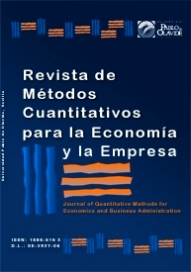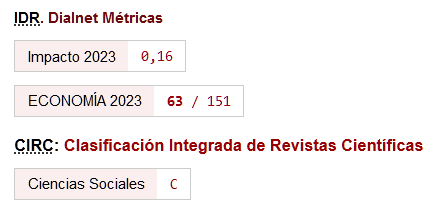The good taste of culture and art: a cause-related marketing strategy
DOI:
https://doi.org/10.46661/rev.metodoscuant.econ.empresa.7819Keywords:
cause-related marketing, consumer behaviour, fresh fruit;, modified ANOVA-type statistic, taste perceptions, Wald-type statisticAbstract
Package claims influence product perceptions. Specifically, prosocial information concerning sustainable organisational practices improves product evaluation. This research evaluates the effect of supporting cultural and artistic activities as a claim that influences taste evaluations. Taste is a metaphor for an emotional response to products. We conducted a mixed model experiment: The claim “Supports cultural/artistic activities” is the between-group variable, and four fruits are the within-subject variable (i.e., guava, pineapple, red apple, and green grapes). Descriptive statistics and a MANOVA analysis show that the sweet and umami taste is enhanced when fruits hold the cultural/artistic claim. This effect is not observed for the sour and bitter taste. Therefore, the results confirm the taste metaphor. Within the cause-related marketing literature, it is possible to interpret that supporting the culture/arts industry has a symbolic meaning for the consumer.
Downloads
References
Al'absi, M., Nakajima, M., Hooker, S., Wittmers, L., Cragin, T., (2012). Exposure to acute stress is associated with attenuated sweet taste. Psychophysiology, 49, 96-103. https://doi.org/10.1111/j.1469-8986.2011.01289.x
Alba, J.W., Williams, E.F., (2013). Pleasure principles: A review of research on hedonic consumption. Journal of Consumer Psychology ,23, 2-18. https://doi.org/10.1016/j.jcps.2012.07.003
Allen, J.S., (2012). The Omnivorous Mind: Our Evolving Relationship with Food. Harvard University Press. https://doi.org/10.4159/harvard.9780674064737
Álvarez del Blanco, R. M., (2020). Brand Beauty unleashed: the value of aesthetics in marketing. Routledge.
https://doi.org/10.4324/9780429025495
Arboleda Arango, A. M., Alonso, J. C., & Arce-Lopera, C. A., (2022). Does this fruit look appetizing? Psychometric modeling of fruit consumption preferences. Acta Agronómica, 71(3). https://doi.org/10.15446/acag.v71n3.101041
Badenes‐Rocha, A., Bigne, E., & Ruiz, C., (2022). Impact of cause‐related marketing on consumer advocacy and cause participation: A causal model based on self‐reports and eye‐tracking measures. Psychology & Marketing, 39(1), 214-226. https://doi.org/10.1002/mar.21590
Barnes, N.G., Fitzgibbons, D.A., (1991). Business-Charity Links: Is Cause Related Marketing in Your Future? Business Forum 16, 20.
Barone, M.J., Miyazaki, A.D., Taylor, K.A., (2000). The influence of Cause-Related Marketing on Consumer Choice: Does One Good Turn Deserve Another? Journal of the Academy of Marketing Science, 28, 248-262. https://doi.org/10.1177/0092070300282006
Bathke, A.C., Friedrich, S., Pauly, M., Konietschke, F., Staffen, W., Strobl, N., Höller, Y., (2018). Testing Mean Differences Among Groups: Multivariate and Repeated Measures Analysis with Minimal Assumptions. Multivariate Behavioral Research, 53, 348-59. https://doi.org/10.1080/00273171.2018.1446320
Baxter, S.M., Ilicic, J., (2015). Three's company: Investigating cognitive and sentiment unit imbalance in co-branding partnerships. Journal of Brand Management, 22, 281-298. https://doi.org/10.1057/bm.2015.7
Berthoud, H.R., Morrison, C., (2008). The brain, appetite, and obesity. Annual Review of Psychology, 59, 55-92. https://doi.org/10.1146/annurev.psych.59.103006.093551
Bigné-Alcañiz, E., Currás-Pérez, R., Ruiz-Mafé, C., Sanz-Blas, S., (2012). Cause-related marketing influence on consumer responses: The moderating effect of cause-brand fit. Journal of Marketing Communications, 18, 265-283. https://doi.org/10.1080/13527266.2010.521358
Catlin, J. R., Luchs, M. G., & Phipps, M., (2017). Consumer perceptions of the social vs. environmental dimensions of sustainability. Journal of Consumer Policy, 40(3), 245-277. https://doi.org/10.1007/s10603-017-9356-x
Chan, K.Q., Tong, E.M.W., Tan, D.H., Koh, A.H.Q., (2013). What do love and jealousy taste like. Emotion, 13, 1142-1149. https://doi.org/10.1037/a0033758
Chernev, A., Blair, S., (2015). Doing well by doing good: The benevolent halo of corporate social responsibility. Journal of Consumer Research, 41, 1412-1425. https://doi.org/10.1086/680089
Davis, C. S., (2002). Statistical methods for the analysis of repeated measurements. Springer, New York.
https://doi.org/10.1007/b97287
Desmet, P.M.A., Schifferstein, H.N.J., (2008). Sources of positive and negative emotions in food experience. Appetite, 50, 290-301. https://doi.org/10.1016/j.appet.2007.08.003
Estes, Z., Brotto, L., Busacca, B., (2018). The value of art in marketing: An emotion-based model of how artworks in ads improve product evaluations. Journal of Business Research, 85, 396-405. https://doi.org/10.1016/j.jbusres.2017.10.017
File, K.M., Prince, R.A., (1998). Cause Related Marketing and Corporate Philanthropy in the Privately Held Enterprise. Journal of Business Ethics, 17, 1529-1539. https://doi.org/10.1023/A:1005869418526
Friedrich, S., Brunner, E., Pauly, M., (2017). Permuting longitudinal data in spite of the dependencies. Journal of Multivariate Analysis, 153, 255-265. https://doi.org/10.1016/j.jmva.2016.10.004
Friedrich, S., Pauly, M., (2018). MATS: Inference for potentially singular and heteroscedastic MANOVA. Journal of Multivariate Analysis, 165, 166-179. https://doi.org/10.1016/j.jmva.2017.12.008
Garcia-Burgos, D., Lao, J., Munsch, S., Caldara, R., (2017). Visual attention to food cues is differentially modulated by gustatory-hedonic and post-ingestive attributes. Food Research International, 97, 199-208. https://doi.org/10.1016/j.foodres.2017.04.011
Goldsmith, R.E., Yimin, Z., (2014). The Influences of Brand-Consumer and Cause-Congruence on Consumer Responses to Cause Related Marketing. Journal of Applied Marketing Theory, 5, 74-95.
https://doi.org/10.20429/jamt.2014.050205
Hagtvedt, H., Patrick, V.M., (2008). Art Infusion: The Influence of Visual Art on the Perception and Evaluation of Consumer Products. Journal of Marketing Research, 45, 379-389. https://doi.org/10.1509/jmkr.45.3.379
Härdle, W.K., Simar, L., (2019). Applied multivariate statistical analysis. Springer International Publishing.
https://doi.org/10.1007/978-3-030-26006-4
Herz, R., (2017). Why you eat what you eat: The science behind our relationship with food. WW Norton & Company. New York.
Hoyer, W.D., Stokburger-Sauer, N.E., (2012). The role of aesthetic taste in consumer behavior. Journal of the Academy of Marketing Science, 40, 167-180. https://doi.org/10.1007/s11747-011-0269-y
Huertas-García, R., Lengler, J., Consolación-Segura, C., (2017). Co-branding strategy in cause-related advertising: the fit between brand and cause. Journal of Product & Brand Management, 26 (2) 135-150. https://doi.org/10.1108/JPBM-07-2015-0939
Hultén, B., (2013). Sensory cues as in-store innovations: Their impact on shopper approaches and touch behavior. Journal of Innovation Management, 1(1), 17-37. https://doi.org/10.24840/2183-0606_001.001_0004
IEG Sponsorship, (2019). Cause Sponsorship Activity & Spending.
Johnson, R.A., Wichern, D.W., (2014). Applied Multivariate Statistical Analysis. Pearson, London, UK.
https://doi.org/10.1002/9781118445112.stat02623
Kim, K., Cheong, Y., Lim, J.S., (2015). Choosing the right message for the right cause in social cause advertising: Type of social cause message, perceived company-cause fit and the persuasiveness of communication. International Journal of Advertising, 34(3), 473-494. https://doi.org/10.1080/02650487.2015.1006081
Konietschke, F., Bathke, A.C., Harrar, S.W., Pauly, M., (2015). Parametric and nonparametric bootstrap methods for general MANOVA. Journal of Multivariate Analysis, 140, 291-301.
https://doi.org/10.1016/j.jmva.2015.05.001
Kringelbach, M.L., Stein, A., van Hartevelt, T.J., (2012). The functional human neuroanatomy of food pleasure cycles. Physiology & behavior, 106, 307-316. https://doi.org/10.1016/j.physbeh.2012.03.023
Lawless, H.T., Heymann, H., (2010). Sensory Evaluation of Food. Principles and Practices, Second. ed. Springer, New York Dordrecht Heidelberg London.
https://doi.org/10.1007/978-1-4419-6488-5
Meier, B.P., Moeller, S.K., Riemer-Peltz, M., Robinson, M.D., (2012). Sweet taste preferences and experiences predict prosocial inferences, personalities, and behaviors. Journal of Personality and Social Psychology, 102(1), 163-174. https://doi.org/10.1037/a0025253
Naletelich, K., Paswan, A.K., (2018). Art infusion in retailing: The effect of art genres. Journal of Business Research, 85, 514-522. https://doi.org/10.1016/j.jbusres.2017.10.030
Naukkarinen, O. (2020). Aesthetics as Space. Aalto korkeakoulusäätiö. Espoo, Finland.
Noel, C., Dando, R., (2015). The effect of emotional state on taste perception. Appetite 95, 89-95. https://doi.org/10.1016/j.appet.2015.06.003
Piqueras-Fizman, B., & Spence, C. (2015). Sensory and hedonic expectations based on food product-extrinsic cues: a review of the evidence and theoretical accounts. Food Quality and Preference, 40, 165-179. https://doi.org/10.1016/j.foodqual.2014.09.013
Pitt, C., Kietzmann, J., Botha, E., Wallström, Å., (2018). Emotions and sentiment: An exploration of artist websites. Journal of Public Affairs, 18, 1-4. https://doi.org/10.1002/pa.1653
Pracejus, J.W., Deng, Q. (Claire), Olsen, G.D., Messinger, P.R., (2019). Fit in cause-related marketing: An integrative retrospective. Journal of Global Scholars of Marketing Science, 30(2), 105-114. https://doi.org/10.1080/21639159.2018.1509365
Raghunathan, R., Naylor, R.W., Hoyer, W.D., (2006). The unhealthy = Tasty intuition and its effects on taste inferences, enjoyment, and choice of food products. Journal of Marketing, 70, 170-184. https://doi.org/10.1509/jmkg.70.4.170
Reinoso-Carvalho, F., Dakduk, S., Wagemans, J., Spence, C., (2019). Not Just Another Pint! The Role of Emotion Induced by Music on the Consumer's Tasting Experience. Multisensory Research, 32(4-5), 367-400.
https://doi.org/10.1163/22134808-20191374
Rentschler, R., Wood, G., (2001). Cause Related Marketing: Can the Arts Afford Not to Participate? Services Marketing Quarterly, 22, 57-69.
https://doi.org/10.1300/J396v22n01_05
Robinson, S.R., Irmak, C., Jayachandran, S., (2012). Choice of Cause in Cause-Related Marketing. Journal of Marketing, 76, 126-139. https://doi.org/10.1509/jm.09.0589
Roschwalb, S.A., (1989). Corporate eyes on the market: Funding the arts for the 1990s. Journal of Arts Management and Law, 19, 73-83. https://doi.org/10.1080/07335113.1989.10593789
Sakai, N., Uneyama, H., Chavasit, V., (2016). Psychological and physiological bases of umami taste perception as related to nutrition, Novel Approaches of Nanotechnology in Food. Elsevier Inc. https://doi.org/10.1016/b978-0-12-804308-0.00020-0
Schaefer, M., Reinhardt, A., Garbow, E., & Dressler, D., (2021). Sweet taste experience improves prosocial intentions and attractiveness ratings. Psychological Research, 85, 1724-1731. https://doi.org/10.1007/s00426-020-01336-x
Schiuma, G., Schiuma, G., (2011). Why arts matter in management, The Value of Arts for Business. Cambridge University Press. https://doi.org/10.1017/cbo9780511852015.003
Shepherd, G.M., (2016). Neurogastronomy, Neurogastronomy. Columbia University Press, New York. https://doi.org/10.7312/shep15910
Silvertown, J., (2017). Dinner with Darwin: Food, Drink, and Evolution. University of Chicago Press.
https://doi.org/10.7208/chicago/9780226489230.001.0001
Tracy, S.E., (2018). Delicious molecules: Big food science, the chemosenses, and umami. The Senses and Society, 13, 89-107.
https://doi.org/10.1080/17458927.2017.1420027
Vanhamme, J., Lindgreen, A., Reast, J., van Popering, N., (2012). To Do Well by Doing Good: Improving Corporate Image Through Cause-Related Marketing. Journal of Business Ethics, 109, 259-274. https://doi.org/10.1007/s10551-011-1134-0
Varadarajan, R.P., Menon, A., (1988). Cause-Related Marketing: A Coalignment of Marketing Strategy and Corporate Philanthropy. Journal of Marketing, 52, 58-74. https://doi.org/10.1177/002224298805200306
Wald, C., (2015). Neuroscience: The aesthetic brain. Nature, 526, S2-S3. https://doi.org/10.1038/526S2a
Wei, W., Kim, G., Miao, L., Behnke, C., & Almanza, B., (2018). Consumer inferences of corporate social responsibility (CSR) claims on packaged foods. Journal of Business Research, 83 (February), 186-201.
https://doi.org/10.1016/j.jbusres.2017.10.046
Westbrook, G., Angus, A., (2023). Top 10 global consumer trends 2023. Euromonitor International. England.
Zhao, G.Q., Zhang, Y., Hoon, M.A., Chandrashekar, J., Erlenbach, I., Ryba, N.J.P., Zuker, C.S., (2003). The Receptors for Mammalian Sweet and Umami Taste. Cell, 115(3), 255-266. https://doi.org/10.1016/S0092-8674(03)00844-4
Zhou, J., Li, J., Jiao, H., Qiu, H., Liu, Z., (2018). The more funding the better? The moderating role of knowledge stock on the effects of different government-funded research projects on firm innovation in Chinese cultural and creative industries. Technovation, 92, 102059. https://doi.org/10.1016/j.technovation.2018.11.002
Zhou, Y., Tse, C.S., (2020). The Taste of Emotion: Metaphoric Association Between Taste Words and Emotion/Emotion-Laden Words. Frontiers in Psychology, 11. 986. https://doi.org/10.3389/fpsyg.2020.00986
Downloads
Published
How to Cite
Issue
Section
License
Copyright (c) 2024 Ana Arboleda, Julio C. Alonso

This work is licensed under a Creative Commons Attribution-ShareAlike 4.0 International License.
Submission of manuscripts implies that the work described has not been published before (except in the form of an abstract or as part of thesis), that it is not under consideration for publication elsewhere and that, in case of acceptance, the authors agree to automatic transfer of the copyright to the Journal for its publication and dissemination. Authors retain the authors' right to use and share the article according to a personal or instutional use or scholarly sharing purposes; in addition, they retain patent, trademark and other intellectual property rights (including research data).
All the articles are published in the Journal under the Creative Commons license CC-BY-SA (Attribution-ShareAlike). It is allowed a commercial use of the work (always including the author attribution) and other derivative works, which must be released under the same license as the original work.
Up to Volume 21, this Journal has been licensing the articles under the Creative Commons license CC-BY-SA 3.0 ES. Starting from Volume 22, the Creative Commons license CC-BY-SA 4.0 is used.










